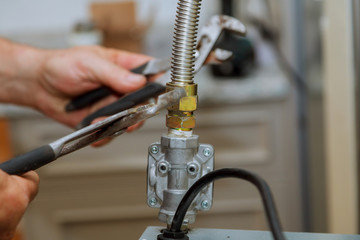Natural gas is a naturally occurring mixture of gaseous hydrocarbons. The main component is methane, but it also contains other higher alkanes. It also contains trace gases such as carbon dioxide, nitrogen, hydrogen sulfide, and helium. These gases have many important uses in our everyday lives, but a common misconception is that natural gas is simply carbon monoxide. In reality, natural gas is a mixture of other gases that are naturally present in our environment.

The problem with using polyethylene pipe is that it has less integrity than steel pipe. A stake driven into the ground can damage it. Make sure that you have your gas lines checked regularly by plumbers. Most gas line leaks occur at the riser connection underground or on steel piping above ground. Leaks can cause a gas smell and raise the gas bill. While leaks are not dangerous, they can be a sign of a faulty gas line. Depending on the source of the leak, it could result in a substantial increase in your gas bill.
The next step in a gas line’s journey is a gate station. Depending on how the gas is transported, there are several types of pipeline stations. Pipelines can be separated into several parts, each of which requires a different pressure. The difference between a pipe’s operating pressure and transmission pressure is often a few inches. Whether the gas is compressed or not, these pipeline stations are crucial to the process of gas delivery.
Gas is carried from the main line to a gas meter in your home. Some service lines carry gas at low pressure, similar to the pressure of a child blowing bubbles in milk. The pressure of the gas is slightly higher than air pressure, so it is easier for it to flow into the burner, resulting in a clean, blue flame. If you are concerned about the safety of your gas lines, consider the following information.
When a gas utility delivers natural gas, it moves it through the distribution system, which is a pipe with a diameter of two to 24 inches. Each section is operated at different pressure, with the highest pressure near the gate station. The pressure is constantly monitored by utility operators and must be maintained within specified limits. The pressure is normally 20 percent of the maximum operating pressure. The pressure can be up to one-fifth of the maximum design pressure.
Natural gas pipelines are constructed in a way that ensures safety. Because they are so close to the public, they must be constructed to withstand high pressures and are regularly checked for safety. Transmission pipelines are constructed of rolled high-carbon steel and are sized for specific roles. The length and diameter of each segment vary by geography and population density. In a populated area, transmission pipelines operate at less than half of the design pressure.
It’s important to hire a licensed plumber to install gas lines. It’s not a difficult job, but it does require specialized equipment and a good understanding of local regulations. Licensed plumbers have the training and experience to safely and effectively install gas lines in residential and commercial buildings. If you are not a professional plumber, they will be able to help you determine what permits you need and what codes you need to follow. They also have the proper tools to install gas lines.
While black steel is the most common material used for gas piping, there are other materials you can use. Copper and brass are widely used in some regions, but you should check with your local utility to see which material is acceptable for your location. Black iron is another common material for gas pipes, although some utilities restrict its use. These pipes are durable but tend to deteriorate over time. In addition to black iron, you should consider hiring a professional for installation.
Propane and natural gas are different. Propane gas has more volatile components. The buildup in these two substances will affect the gas flow and can even damage a pilot light. To avoid any problems, you should get professional assistance to clean your gas lines. It is a relatively inexpensive service that can help you ensure that you are safe from accidents. If you suspect a leak, call a plumber right away. If you notice an exposed gas line, call a plumber immediately.
Pipelines are composed of several interconnected pipelines with small diameters. The purpose of these pipes is to transport products from the production area to the end-user. Among these are feeder lines that transport the gas to downstream homes, and pipelines that are used to distribute products to storage tanks. Pipelines construction projects encompass the civil engineering required to lay the pipeline, the installation of pump/compressor stations, and the installation of field devices for remote operations. Upon completion of the pipeline project, customers can sign up for capacity rights.